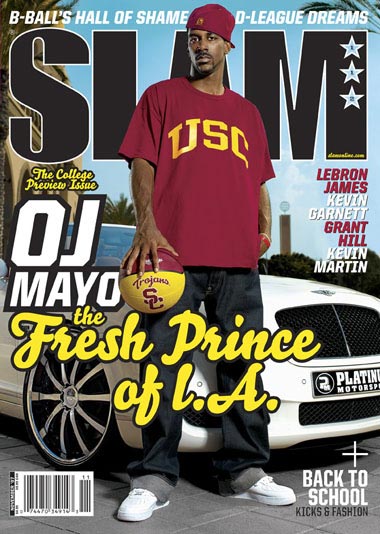Business Swagger Sold Separately
 It’s unfair to stir the problem pot without posing solutions but I can’t resist. Shall we begin with the latest in a series of scholar-athlete type infractions that are under National Collegiate Association of Athletics (NCAA) investigation. I’ll spare you the monotony of news review suffice it to say that the University of Southern California has sanctioned itself due to violations that involve former Trojan O.J. Mayo, now a member of the NBA’s Memphis Grizzlies. In our land you can’t be both amateur and professional at the same time any more than you can be both a Lakers and Celtics fan. Long story short, Mayo is alleged to have taken money from a booster member while at USC for his “One-and-Done” year. Long story shorter, to quote Snoop Dogg, “Now this type of thing happens all the time…”
It’s unfair to stir the problem pot without posing solutions but I can’t resist. Shall we begin with the latest in a series of scholar-athlete type infractions that are under National Collegiate Association of Athletics (NCAA) investigation. I’ll spare you the monotony of news review suffice it to say that the University of Southern California has sanctioned itself due to violations that involve former Trojan O.J. Mayo, now a member of the NBA’s Memphis Grizzlies. In our land you can’t be both amateur and professional at the same time any more than you can be both a Lakers and Celtics fan. Long story short, Mayo is alleged to have taken money from a booster member while at USC for his “One-and-Done” year. Long story shorter, to quote Snoop Dogg, “Now this type of thing happens all the time…”
This we can be certain because aside from personal anecdotes from friends who have played Division I basketball, there’s a really good documentary that recounts the dominance of the University of Miami Football program in the 1980s. And it substantiates both the claim and perhaps even the need for monetary compensation of collegiate athletes. The issue is not how coaches and players leave university sanctions in their wake. That’s as old as sports it seems and simply put, not cool. But what of the exploitation of an amateur? Can we call what happens to Division I athletes exploitation or does such labeling border on defamation? I know this: collegiate basketball is big business and success brings in lucre from sources ranging from TV to ticket sales and apparel.
So my honest question is, “What happens when you invite say, young poor studs, to come play at a school backed by vested alumni and opportunistic investors?” Save you the time. Today’s stud does what most would when the diamonds shimmer. He asks to get in on the show whether he’s within his rights or not. After all, even those Miami Hurricanes from the 1980s knew they had something marketable – TALENT. So back to my original question of how you adequately compensate the scholar-athlete. Don King is quoted as having said, “I could have a $1 million check in my hand to give to someone off the streets. They’ll say, ‘To hell with that. Give me $10,000 in cash.'” If King is right then a four-year scholarship is the analogous check because most kids now don’t plan to stay and if they do, college hoop may as well be a job because it’s the largest stage on which they’ve ever been. Dilemma Dilemma. Kids bring in millions to get an education that’s priceless. But we all know what priceless means to an impetuous young athlete. And if the kids aren’t buying the “incalculable value of earning potential ” speech, can we really expect the NCAA to trade its pro-like atmosphere for past preparatory innocence?
Just had a variation of this conversation over dinner this weekend. My take is that the entire system needs an overhaul, but that is unlikely because there is far too much incentive (cash) to maintain the status quo.
A lot of the top programs operate above and apart from the institutions that they represent on the court/field. It is difficult to send home the message of delayed gratification when education often takes a back seat to Sportscenter highlights, tournament appearances and bowl games.
awesome stuff thanx
Very interesting! I totally missed this. Neat looking blog by the way! Have a good day!